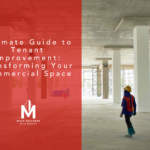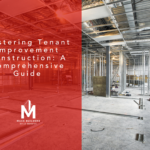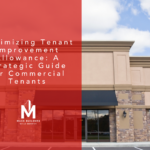Tenant improvement construction is essential for businesses looking to tailor their leased spaces to better suit operational needs and aesthetic preferences. This guide provides an in-depth look at how to efficiently handle these projects, ensuring they align with both tenant expectations and budgetary constraints.
What is Tenant Improvement Construction?
Tenant improvement (TI) construction encompasses the modifications made to a commercial space by a tenant, often supported financially through a tenant improvement allowance provided by the landlord. These modifications can range from simple cosmetic updates to complete overhauls of the interior structure.
Key Components of Tenant Improvement Construction
- Design and Layout Adjustments: Customizing the space to fit specific business operations.
- Infrastructure Upgrades: Enhancing or installing new electrical, plumbing, or HVAC systems.
- Aesthetic Enhancements: Updating finishes and fixtures to reflect brand identity.
Advantages for Tenants and Landlords
- Customization: TI allows tenants to personalize spaces, potentially increasing employee satisfaction and productivity.
- Value Increase: For landlords, well-executed improvements can elevate property appeal, boosting its long-term value and marketability.
Strategic Planning for Tenant Improvement Projects
- Comprehensive Needs Analysis: Start with a detailed assessment of what the business needs from the space. Consider how different layouts, designs, or technologies might enhance operational efficiency.
- Expert Team Assembly: Include architects, interior designers, and contractors who specialize in commercial renovations. Their expertise will be crucial in avoiding common pitfalls.
- Thorough Cost Evaluation: Develop a realistic budget that covers all aspects of the improvements, including hidden costs like downtime during renovations.
Effective Management of Tenant Improvement Construction
- Timeline Synchronization: Align improvement plans with lease start dates and business operation schedules to minimize disruptions.
- Quality Assurance: Regularly review construction progress to ensure that all work meets the agreed standards and adheres to the project timeline.
- Adherence to Regulations: Stay compliant with all local zoning laws and building codes, and ensure all necessary permits are obtained.
Navigating Challenges in Tenant Improvement Construction
- Avoiding Delays: Ensure that all design decisions and material selections are finalized early to prevent scheduling delays.
- Managing Costs: Keep a detailed record of expenditures and maintain a contingency fund to manage unexpected costs effectively.
- Coordinating Stakeholders: Regular meetings with the landlord, contractors, and design teams can help align expectations and resolve conflicts swiftly.
Design Considerations for Effective Spaces
Maximizing Space Utilization
Effective space planning is vital. Consider how your layout can enhance workflow and accommodate future growth.
Incorporating Technology
Modern businesses require modern solutions. Integrating advanced technological infrastructure is key for a functional space.
Aesthetics and Branding
The interior design should reflect your brand’s identity and culture, creating a welcoming environment for both employees and clients.
Navigating Permits and Regulations
Dealing with local building codes and obtaining the necessary permits can be one of the most challenging aspects of tenant improvements. Ensure you understand the local regulations and have all the required approvals before beginning construction.
Strategic Planning for Tenant Improvement Projects
- Comprehensive Needs Analysis: Start with a detailed assessment of what the business needs from the space. Consider how different layouts, designs, or technologies might enhance operational efficiency.
- Expert Team Assembly: Include architects, interior designers, and contractors who specialize in commercial renovations. Their expertise will be crucial in avoiding common pitfalls.
- Thorough Cost Evaluation: Develop a realistic budget that covers all aspects of the improvements, including hidden costs like downtime during renovations.
Tenant Improvement Allowance per Square Foot in Major Texas Cities
Understanding the typical tenant improvement allowance (TIA) rates per square foot in major cities can be crucial for tenants and landlords negotiating lease terms. Texas, being a large and economically diverse state, shows some variation in these rates depending on the city and type of commercial space. Here’s a detailed look at the TIA per square foot in some of Texas’s major cities:
Dallas
In Dallas, the commercial real estate market is robust, with a significant amount of new development and renovation in progress. The average tenant improvement allowance for Class A office spaces ranges from $30 to $50 per square foot. This allowance is designed to attract high-value tenants looking for premium office spaces in prime locations, such as Downtown Dallas or the Uptown area.
Houston
Houston’s market has a strong focus on energy and medical sectors, influencing its commercial real estate dynamics. Here, tenant improvement allowances can vary widely, but on average, Class A office spaces receive between $25 and $45 per square foot. This variance largely depends on the age of the building and its location, with newer buildings in areas like the Houston Energy Corridor or the Texas Medical Center often at the higher end of this range.
Austin
Austin’s booming tech industry has made it a hotspot for commercial real estate development. The city sees a higher demand for creative and flexible office spaces, especially in tech-centric areas like Downtown Austin and the Domain. Tenant improvement allowances here are competitive, with averages ranging from $30 to $60 per square foot for Class A office spaces, reflecting the high demand and the city’s ongoing development boom.
San Antonio
San Antonio offers a more cost-effective market compared to its larger Texan counterparts. The average tenant improvement allowance for Class A office spaces typically ranges from $20 to $40 per square foot. The lower cost of living and operational costs in San Antonio make it an attractive option for businesses looking to maximize their TIA while still accessing quality office spaces, particularly in growing areas like North San Antonio.
Fort Worth
In Fort Worth, the commercial real estate market is diverse, catering to industries from logistics to technology. Tenant improvement allowances in this city average between $25 and $45 per square foot for Class A office spaces. Key business districts like Sundance Square and the Cultural District are particularly popular, with allowances reflecting the prime nature of these locations.
Conclusion
Embarking on a tenant improvement project offers an exciting opportunity to tailor your commercial space to your exact business needs. Success in such endeavors requires understanding the specifics of tenant improvement allowances, savvy negotiation, and effective project management.
Ready to transform your leased space with expert precision? Maxx Builders is here to guide you every step of the way. Our dedicated team ensures your project is executed flawlessly, supporting your goals with our expertise in commercial construction.
Take the first step towards your ideal commercial environment. Connect with us today by visiting our Commercial Construction Project Inquiry page. Let Maxx Builders help you turn your vision into reality—efficiently and beautifully.
Frequently Asked Questions About Tenant Improvement Construction
What is a tenant improvement allowance?
A tenant improvement allowance (TIA) is a sum of money that the landlord provides to the tenant to cover part or all of the costs associated with customizing a leased space to suit the tenant’s specific business needs. This allowance can cover expenses like new flooring, walls, ceilings, and sometimes even furniture and fixtures.
How is the tenant improvement allowance calculated?
Tenant improvement allowances are typically calculated based on the square footage of the leased space. The specific amount can vary depending on the location, type of property, and market conditions. Generally, landlords offer a per-square-foot allowance that tenants can use to estimate the total funds available for renovations.
Can tenant improvement allowances be negotiated?
Yes, tenant improvement allowances are often a key point of negotiation in lease agreements. Tenants can negotiate the amount of the allowance, the scope of work it covers, and the disbursement schedule, among other details. It’s advisable for tenants to come prepared with a detailed plan and budget to strengthen their negotiating position.
What happens to any unused tenant improvement allowance?
The handling of unused tenant improvement allowance funds depends on the lease agreement’s specific terms. Some landlords may allow tenants to apply unused funds towards other lease-related expenses, such as rent reduction or additional improvements. However, in many cases, any unused portion of the allowance reverts back to the landlord.
Are there any tax implications for tenant improvements?
Yes, tenant improvements can have tax implications for both the tenant and the landlord. For tenants, improvements might be considered capital expenditures and could be eligible for depreciation. Landlords might be able to treat the allowances as a deductible expense. Both parties should consult with tax professionals to understand their specific situation.
How long do tenant improvement projects typically take?
The duration of tenant improvement projects can vary widely depending on the scope of work. Minor modifications might take a few weeks, while extensive renovations could take several months. It’s essential for tenants and landlords to agree on a realistic timeline that accommodates the tenant’s move-in schedule and any constraints posed by the property.
Who oversees the construction work in a tenant improvement project?
Typically, the tenant oversees the construction work for tenant improvements. The tenant often hires contractors and manages the project to ensure that the work aligns with their specific needs and standards. However, some landlords may require oversight or approval rights during the construction phase to ensure that the improvements comply with building regulations and lease agreements.




